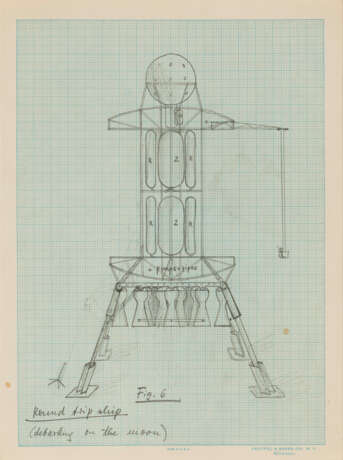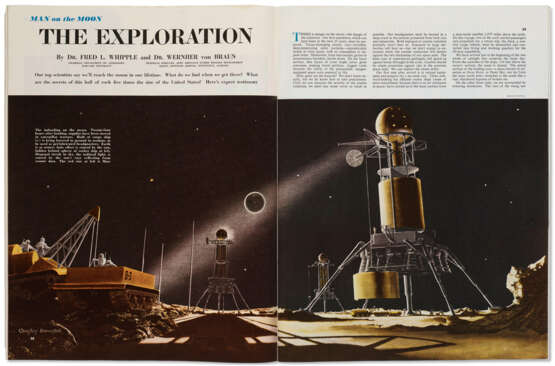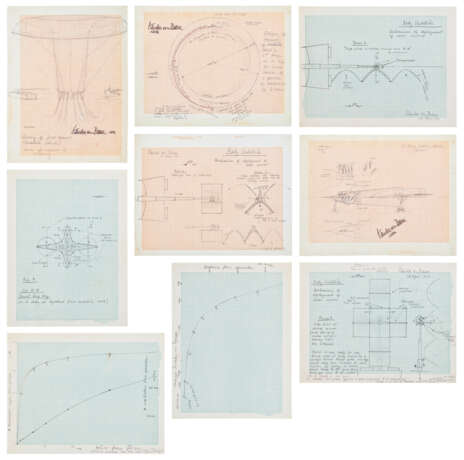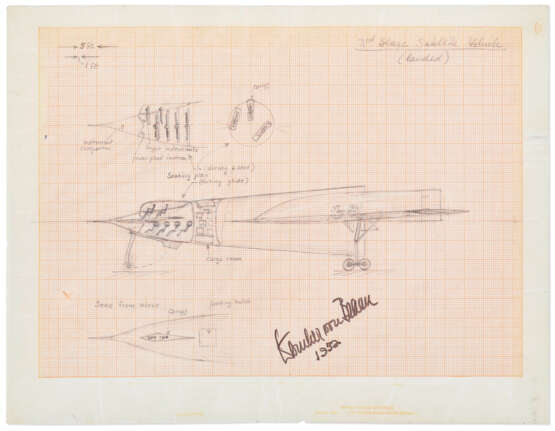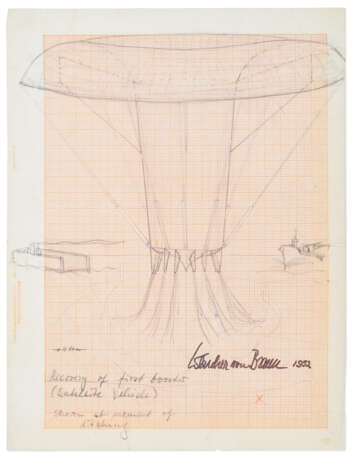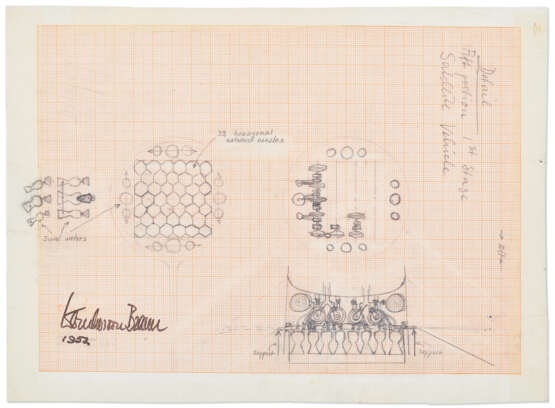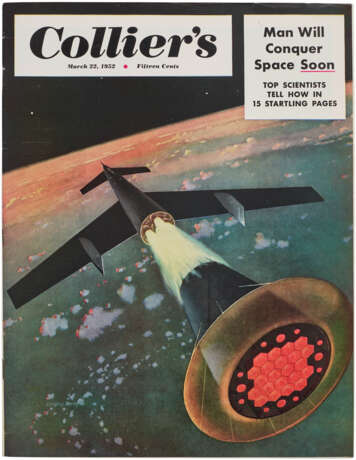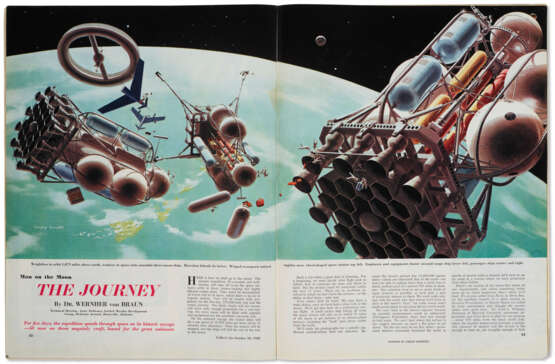ID 1291226
Лот 228 | ARCHIVE OF SCIENTIFIC DRAWINGS, SCHEMATICS, AND CALCULATIONS
Оценочная стоимость
$ 15 000 – 25 000
Original material by Wernher von Braun for Collier’s era-defining "Man Will Conquer Space Soon!" series (1952–1954), which popularized von Braun’s detailed vision for human space exploration. The archive includes the drawings and additional material that von Braun drafted for artists Chesley Bonestell, Fred Freeman and Rolf Klep as they began illustrating his articles “Crossing the Last Frontier” (22 March 1952), “Man on the Moon: The Journey” (18 October 1952), “Man on the Moon: The Exploration” (25 October 1952) and “Baby Space Station” (27 June 1953). In these articles, von Braun presents his ideas for completing round-trip voyages and moon landings as well as establishing orbiting space stations and planetary field stations—and his cutting-edge designs are brought to life in the many vivid works on the pages of Collier’s.
Named by biographer Dennis Piszkiewicz as “The Man who Sold the Moon,” von Braun’s singular contribution to the popular imagination and visual culture surrounding space travel across the 20th century is immense. The designs and specifications not simply dreamt up by von Braun but painstakingly worked out by hand had wide-reaching and immediate impact on what it meant for rocket scientists and the general public alike to imagine, for example, a lunar module touching down in one of the Moon’s craters or a rocket ship blasting off to Mars—both decades before either feat would be achieved. The use of von Braun’s drawings as reference material for Bonestell’s, Freeman’s and Klep’s artwork is readily apparent on the covers of Collier’s. The striking, red-hot hexagonal exhaust nozzles on the cover of the first issue in the Man Will Conquer Space Soon! series is instantly recognizable in von Braun’s manuscript source, which showcases the schematics for the full 39-piece hexagonal array. (Whilst the hexagons are correct, von Braun objected to the red-hot color, saying that a good engineer would prevent this overheating.) And the lunar lander intricately set down on paper by von Braun maps almost seamlessly onto the dramatic rendering featured on the cover of the 15 October issue.
That artists such as Chelsey Bonestell had such thorough, innovative and informed designs to base their genre-defining artwork on was crucial to the development of the iconic Space Age style that rapidly permeated global cultures and directly shaped how space travel has been depicted in the decades since.
Comprises:
For "Crossing the Last Frontier" by Dr. Wernher von Braun, published 22 March 1952:
1. “3rd Stage Satellite Vehicle, (landed),” pencil drawing.
2. “Detail, Aft position 1st stage, Satellite Vehicle,” pencil drawing.
3. “Ellipse of ascent of Satellite Vehicle’s 3rd stage on its trip to Space Station of a period of revolution of 2 hours," pencil diagram.
4. “Recovery of first booster (Satellite Vehicle) shown at moment of ditching,” pencil drawing.
Each item signed and dated in black ink “Wernher von Braun, 1952.”
For "Man on the Moon: The Journey" by Dr. Wernher von Braun, published 18 October 1952:
5. “Round trip ship (debarking on the moon),” pencil drawing. This sketch is matted and framed to an overall size of 17 x 191/2 in.
6. “Cut A-A, Round trip ship, (as it looks at departure from satellite orbit),” pencil diagram.
7. “Tank volumes, ”Von Braun’s calculations for the tanks of the “Round trip ship," one page.
8. Extensive trigonometric calculations completed by von Braun, as well as an angular diagram, for the trajectories of spacecraft leaving Earth orbit, one page.
9. “Distance from geocenter” against “Velocity in voyaging ellipse,” with 19,500 MPH denoted as “Cut-off point (1)” and 22,200 MPH marked “Perigee.” Pencil graph.
10. “Radiusvector angle from perigee” against “Hours from perigee (which is 2 minutes more than flight time from ignition maneuver 1).” Pencil graph.
For "Man on the Moon: The Exploration" by Dr. Fred L. Whipple and Dr. Wernher von Braun, published 25 October 1952:
11. “Moon Transport,” pencil sketch annotated with dimensions in red pencil.
12. A similar vehicle, pencil sketch, verso with an additional rough orbital diagram, captioned “0.6 mi/sec.”
For "Baby Space Station" by Dr. Wernher von Braun with Cornelius Ryan, published 27 June 1953:
13. “Baby Satellite, Orbit and track of ascent,” pencil drawing, signed and dated in pencil, “Wernher von Braun, 15 April 1953.”
14-15-16. “Baby Satellite, Mechanism of deployment of solar mirror,” three separate technical diagrams, each signed and dated in pencil, “Wernher von Braun, 20 April 53.”
17. Autograph letter signed (“Wernher”), 2 pages, 20 April 20 [1953], to Collier's editor Cornelius Ryan, transmitting some of these sketches.
18. Second autograph letter of the same date (“20 April, late”), also signed “Wernher,” reads: “Dear Connie: Here’s the rest of my sketches. Rush the photostats back to me, will you?”
19. “Radar antenna (3000 Mcps),” pencil sketch with autograph note to illustrator Fred Freeman.
20. "Trailer (1). Telemeter receiver and Radar trailer (1),” pencil drawing, signed and dated, “Wernher von Braun, 20 April 53”
21. "Trailer (1). Rear wall. Floor plan,” pencil drawing, signed “Wernher von Braun.”
22. “Trailer (2). Television receiver and Command transmitter trailer (2)," pencil drawing signed “Wernher von Braun.”
23. “Trailer (2). Floor plan," pencil drawing.
24. Autograph letter signed (“Wernher”), three pages recto and verso, 25 April 1953, to Cornelius Ryan, discussing several aspects of the headquarters and field stations to be portrayed in the story.
25. “Typical telemeter channel decoder panel / Auxiliary panels for telemeter decoding,” pencil sketches.
26. “Scheme of a ‘Viewer,'” pencil sketch.
| Место происхождения: | США |
|---|---|
| Категория аукционного дома: | Письма, документы и рукописи |
| Место происхождения: | США |
|---|---|
| Категория аукционного дома: | Письма, документы и рукописи |
| Адрес торгов |
CHRISTIE'S 20 Rockefeller Plaza 10020 New York США | ||||||||||||||
|---|---|---|---|---|---|---|---|---|---|---|---|---|---|---|---|
| Предосмотр |
| ||||||||||||||
| Телефон | +1 212 636 2000 | ||||||||||||||
| Факс | +1 212 636 4930 | ||||||||||||||
| Условия использования | Условия использования | ||||||||||||||
| Транспортировка |
Почтовая служба Курьерская служба Самовывоз | ||||||||||||||
| Способы оплаты |
Банковский перевод | ||||||||||||||
| Часы работы | Часы работы
|
